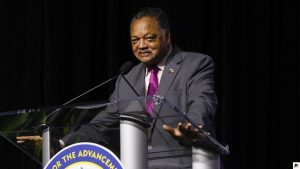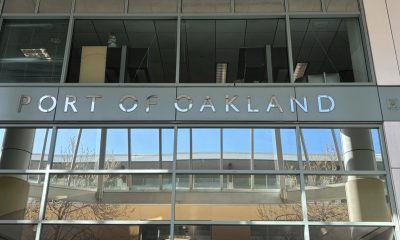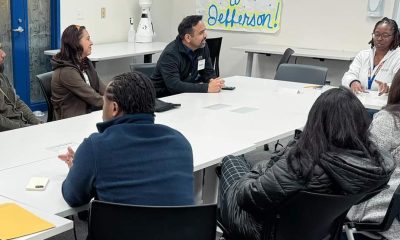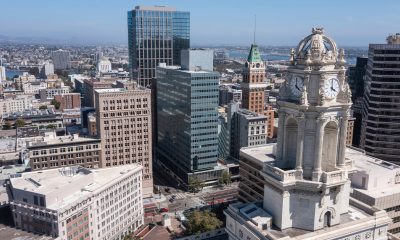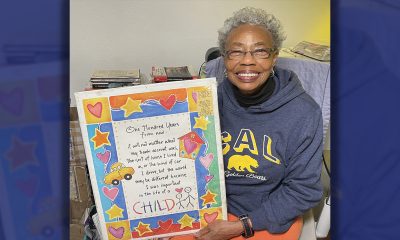Community
OUSD Ended Oakland High’s Onsite COVID Testing, Parents and Teachers Want It Back
Oakland High School students attend school from 8:30 a.m. to 3:30 p.m. every day except Wednesdays, when they get off school around 1:30 p.m. This allows them one day a week in which they have enough time to get tested after school. When testing is onsite, students can get tested during the school day.
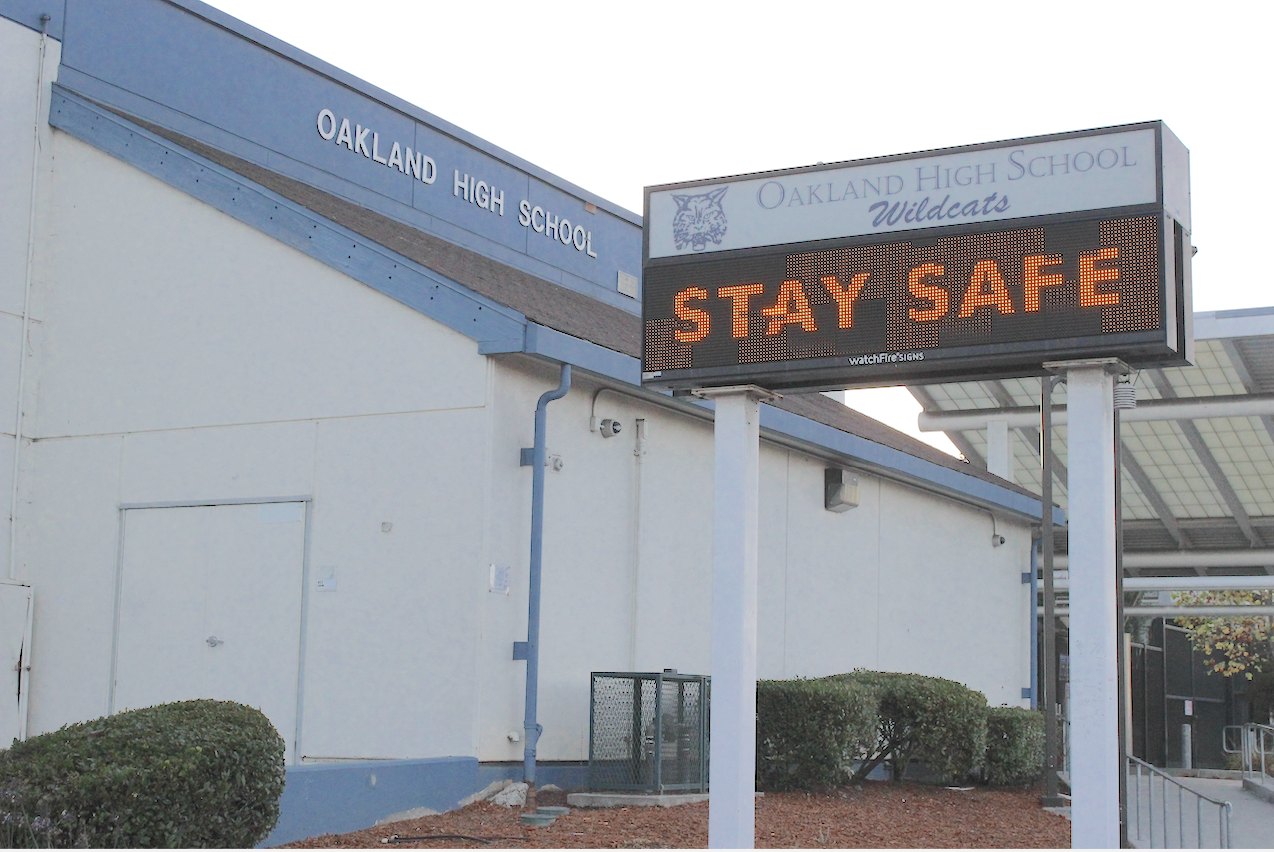
On August 30, The Oakland Unified School District informed Oakland High School that they would stop providing onsite COVID-19 testing at the school, but many teachers and parents want the testing services to resume.
“If you don’t test for it, you don’t see that it’s there,” said Christy Mitchell, an Oakland High School teacher. She, and the other teacher who spoke to The Oakland Post for this article requested to use pseudonyms because they fear possible retaliation for speaking out.
Mitchell thinks it is likely there have been COVID-19 cases present in the school that the district has not documented because student and staff’s ability to get tested was greatly reduced when consistent onsite testing left campus. She worries there could be people attending school who have COVID but are not showing symptoms and could unknowingly spread the virus.
Anya Burston, another Oakland High School teacher, was directed to other OUSD COVID sites when she wanted to get tested last week, but she found them inaccessible.
“They gave me the list of the other sites where we could get tested, but they’re only open from 8 to 4,” said Burston. “We work from 8:00 to 3:30.”
If one factors in commuting time, Burston claims, it’s effectively impossible for teachers to get tested at district sites if they are not at the school a teacher is already working at.
Oakland High School students attend school from 8:30 a.m. to 3:30 p.m. every day except Wednesdays, when they get off school around 1:30 p.m. This allows them one day a week in which they have enough time to get tested after school. When testing is onsite, students can get tested during the school day.
According to OUSD Director of Communications John Sasaki, the district wants to bring back consistent testing to the site but is facing difficulties related to capacity. The district provided a one-day pop-up testing service on Wednesday, and said he said such a service possibly could happen again next week, too.
He encourages students and staff to pursue other testing options.
“We also encourage our students and staff to visit our regional testing hubs, take advantage of community clinics, or get tested by their healthcare provider,” Sasaki said. “Likewise, we have provided at-home tests at all of our schools for families and staff to take when needed. Students are not allowed to miss class for COVID testing.”
The take-home tests are rapid tests, which have a higher rate of false positives and negatives then CRP tests, which take longer to deliver their results. Burston said she asked for an at-home test after not being able to get tested at Oakland High School, but was told there were none available because the school had run out.
She was eventually able to get tested at the pop-up service on Wednesday, but she said when she accessed the service she saw only one other teacher getting tested. She thinks people missed out on utilizing the pop-up testing service because the district informed staff and students about the site less than 24 hours before it appeared.
Sasaki said the district stopped providing regular on-site testing to Oakland High School after the number of positive cases began to decline at the school. During the first week of school, the district has confirmed there were 22 positive cases among staff and students at Oakland High School. This number dropped to five cases during the schools’ second week and then dropped again to one case during the third week.
Oakland High School had the most positive cases of any public school in Oakland during the first week of school, which lead to an entire class of students going into quarantine. The school also had abundantly available testing at that time.
Mitchell and Burston said during the first week of school, when some Oakland High School teachers heard a student in their class had come into contact with a person who had tested positive for the virus, they would take their entire class to get tested on site. At almost all other district sites during this time, students and staff did not have onsite testing available.
“Obviously with that amount of testing you’re going to have a lot more cases coming up,” said Mitchell. “The more testing we did the more cases we found.”
By the second and third week of school, Mitchell and Burston said although tests were still provided onsite, the school would run out of them. When teachers would take their classes to get tested, sometimes there weren’t enough available for everyone.
As testing became less available, COVID-19 numbers went down. During the fourth week of school, when testing facilities had left the site, the district documented no COVID-19 cases at Oakland High School. Last week, the fifth week of school, there were two documented cases.
“I think the optics are a huge concern for the district,” Mitchell said. “But pretending it’s not happening while you’re not testing for it is very disingenuous.”
A group of Oakland High School teachers are working to change the situation and hoping to pressure the district to bring back onsite testing. A few days after they received official word that the district was removing onsite testing, they began talking with each other.
“Many of us are really frustrated and we collectively felt we had to do something if the school and the district isn’t doing anything,” said Burston.
The teachers decided to spread word about the issue through flyers they created demanding onsite testing every day at the school and other COVID-19 safety measures.
They printed 300 flyers they put on walls throughout school and about 1,600 smaller flyers that they distributed to parents and students. The flyers linked to an online petition, which over 150 teachers, students, educators and community members have signed. The petition has interactive elements, in that it asks if those signers would be interested in attending a parent/student/teacher safety meeting.
Jennifer, a parent of a student at Oakland High School, signed the petition. She asked to only be identified by her first name, as other members of her family work at OUSD and she fears they could be retaliated against in reaction to her speaking out. She works in an ER and sees devastation COVID causes first hand.
“I know there’s a lot of kids out there with COVID because our ERs are packed,” she said. “I always support the teachers and I think onsite testing is definitely a necessity.”
Mitchell said teachers are considering direct actions to work towards improving COVID-19 safety measures at Oakland High School.
If Oakland High School teachers were to take such actions, it wouldn’t be the first time in recent history they have done so. On December 10, of 2018, the vast majority of Oakland High School teachers called in sick en masse and rallied outside of Oakland’s City Hall to protest what they saw as low wages and ineffective tactics of the Oakland Education Association, their union.
On January 18, of 2019, they participated in a similar “sickout” action, but this time students and teachers from other schools joined them. Participants estimated over 300 people in total marched to support teacher demands. These actions came just before the Oakland Education Association sanctioned educator strike, which lasted from February 21 to March 1, 2019.
But Oakland High teachers say before they engage in an organized actions related to COVID-19 safety, parents first need to understand what they are working toward, and teachers need their support.
“I think it’s really vital for parents and teachers to be working hand in hand on this,” said Mitchell.
The Oakland Post’s coverage of local news in Alameda County is supported by the Ethnic Media Sustainability Initiative, a program created by California Black Media and Ethnic Media Services to support community newspapers across California.
Activism
Oakland Post: Week of April 17 – 23, 2024
The printed Weekly Edition of the Oakland Post: Week of April 17 – 23, 2024

To enlarge your view of this issue, use the slider, magnifying glass icon or full page icon in the lower right corner of the browser window. ![]()
Activism
Oakland Schools Honor Fred Korematsu Day of Civil Liberties
Every Jan. 30, OUSD commemorates the legacy of Fred Korematsu, an Oakland native, a Castlemont High School graduate, and a national symbol of resistance, resilience, and justice. His defiant stand against racial injustice and his unwavering commitment to civil rights continue to inspire the local community and the nation. Tuesday was “Fred Korematsu Day of Civil Liberties and the Constitution” in the state of California and a growing number of states across the country.
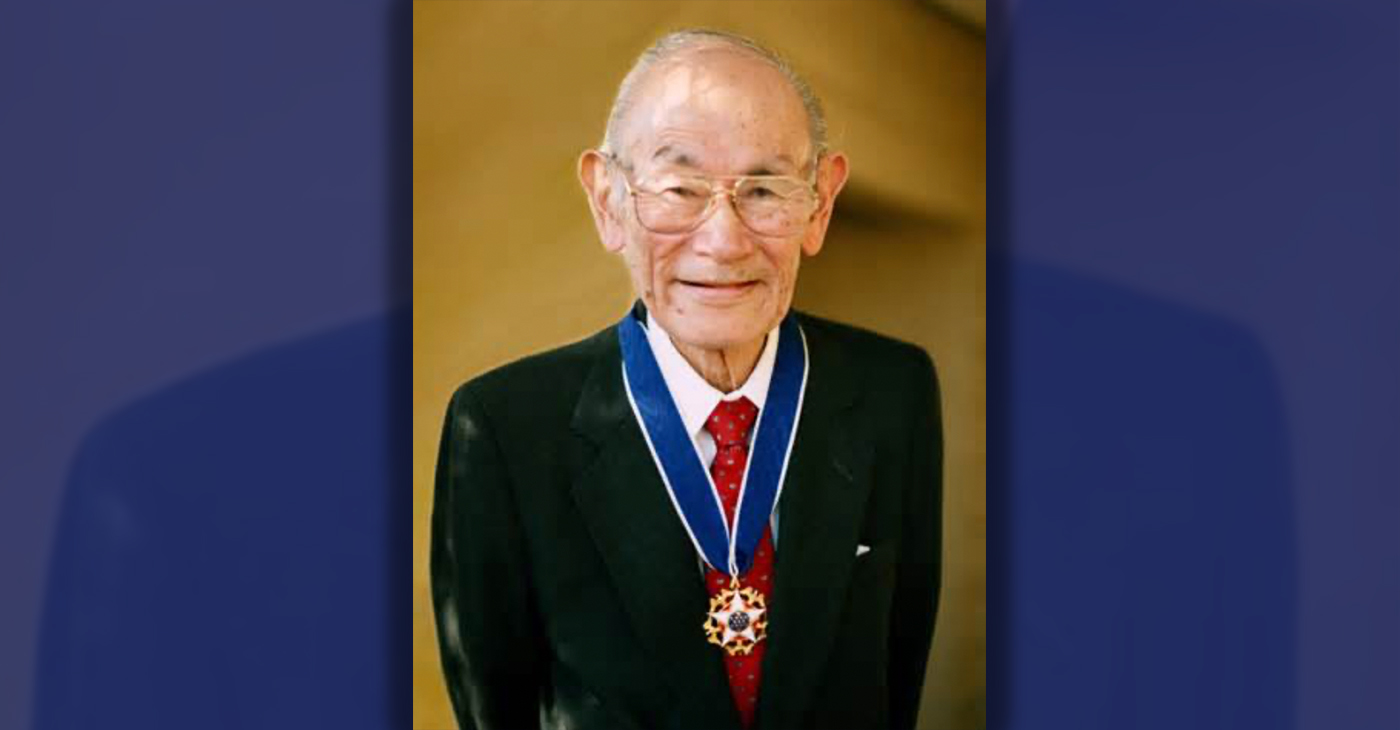
By Post Staff
Every Jan. 30, OUSD commemorates the legacy of Fred Korematsu, an Oakland native, a Castlemont High School graduate, and a national symbol of resistance, resilience, and justice.
His defiant stand against racial injustice and his unwavering commitment to civil rights continue to inspire the local community and the nation. Tuesday was “Fred Korematsu Day of Civil Liberties and the Constitution” in the state of California and a growing number of states across the country.
One OUSD school is named in his honor: Fred T. Korematsu Discovery Academy (KDA) elementary in East Oakland.
Several years ago, founding KDA Principal Charles Wilson, in a video interview with anti-hate organization “Not In Our Town,” said, “We chose the name Fred Korematsu because we really felt like the attributes that he showed in his work are things that the children need to learn … that common people can stand up and make differences in a large number of people’s lives.”
Fred Korematsu was born in Oakland on Jan. 30, 1919. His parents ran a floral nursery business, and his upbringing in Oakland shaped his worldview. His belief in the importance of standing up for your rights and the rights of others, regardless of race or background, was the foundation for his activism against racial prejudice and for the rights of Japanese Americans during World War II.
At the start of the war, Korematsu was turned away from enlisting in the National Guard and the Coast Guard because of his race. He trained as a welder, working at the docks in Oakland, but was fired after the bombing of Pearl Harbor in 1941. Fear and prejudice led to federal Executive Order 9066, which forced more than 120,000 Japanese Americans out of their homes and neighborhoods and into remote internment camps.
The 23-year-old Korematsu resisted the order. He underwent cosmetic surgery and assumed a false identity, choosing freedom over unjust imprisonment. His later arrest and conviction sparked a legal battle that would challenge the foundation of civil liberties in America.
Korematsu’s fight culminated in the Supreme Court’s initial ruling against him in 1944. He spent years in a Utah internment camp with his family, followed by time living in Salt Lake City where he was dogged by racism.
In 1976, President Gerald Ford overturned Executive Order 9066. Seven years later, the 9th Circuit Court of Appeals in San Francisco vacated Korematsu’s conviction. He said in court, “I would like to see the government admit that they were wrong and do something about it so this will never happen again to any American citizen of any race, creed, or color.”
Korematsu’s dedication and determination established him as a national icon of civil rights and social justice. He advocated for justice with Rosa Parks. In 1998, President Bill Clinton gave him the Presidential Medal of Freedom saying, “In the long history of our country’s constant search for justice, some names of ordinary citizens stand for millions of souls … To that distinguished list, today we add the name of Fred Korematsu.”
After Sept. 11, 2001, Korematsu spoke out against hatred and discrimination, saying what happened to Japanese Americans should not happen to people of Middle Eastern descent.
Korematsu’s roots in Oakland and his education in OUSD are a source of great pride for the city, according to the school district. His most famous quote, which is on the Korematsu elementary school mural, is as relevant now as ever, “If you have the feeling that something is wrong, don’t be afraid to speak up.”
Community
For Cervical Cancer Month, Medical Community Focused on Education
January was Cervical Cancer Awareness Month. Physicians, advocates and others in the medical community commemorated the month by raising awareness about a form of cancer they say is highly preventable and treatable. Cervical cancer is caused by a virus called the human papillomavirus (HPV) and it develops slowly over time but can be prevented with proper care in girls as young as 13 years old.

By Magaly Muñoz
January was Cervical Cancer Awareness Month.
Physicians, advocates and others in the medical community commemorated the month by raising awareness about a form of cancer they say is highly preventable and treatable.
Cervical cancer is caused by a virus called the human papillomavirus (HPV) and it develops slowly over time but can be prevented with proper care in girls as young as 13 years old.
Sonia Ordonez, an OBGYN and gynecology surgeon at Kaiser Permanente, stated that as soon as people with cervixes reach the maturity reproductive age, they should start taking preventative measures like getting the HPV vaccine. The vaccine involves a series of two-doses for people aged 9 through 14 or three-doses for people 15 through 45 years old.
“I see a lot of young women who can’t remember or may not have gotten [the vaccine] when they were younger, or maybe got one, but we can give them the series of vaccines and restart at any point in time,” Ordonez said.
She said that cervical cancer is not the only cancer caused by HPV. Strains of the virus can also lead to throat, anal and penile cancers.
Screening is also an effective way to check for cervical cancer and should be done every three years after someone turns 21, doctors recommend. It is best to start as early as possible to catch occurrences early.
Ordonez said that this cancer is also more likely found in people of color and has led to more deaths overall.
A Mayo Clinic article published last month stated that Black women are more likely to be diagnosed and die of cervical cancer, compared to White women in the U.S.
2,000 Black women are diagnosed every year with cervical cancer and 40% die as a result.
“This disparity is not due to genetic differences among White, Black or Hispanic women, but rather related to systemic racism, access to healthcare and socioeconomic factors,” Dr. Olivia Cardenas-Trowers, a Mayo Clinic urogynecologist, said in the article.
Ordonez stated that immigrant women are also highly susceptible to the cancer, as many Latin American countries may not have accessibility to screenings or lack of insurance makes it harder for them to get tested.
Hispanic women are 40% more likely to be diagnosed with cervical cancer, and 30% more likely to die from it, as compared to non-Hispanic White women, according to the Office of Minority Health.
Family medicine physician, Joy Anyanwu, stated that the pandemic contributed to hesitancy about getting cervical cancer screenings among some women. Other factors are people’s aversion to vaccines, parents not wanting to believe that their children are or will become sexually active, and doubt about the overall effectiveness of the vaccine.
“The vaccine is very safe — over 97% effective in preventing cervical cancer,” Anyanwu said. “Even if you aren’t having sex, the earlier you start would actually help.”
Anyanwu said she understands that parents might not want to ask questions about their children’s reproductive health, but it’s a mindset that can be a barrier to having important conversation about prevention or care.
To keep families their families and communties healthy, the doctor emphasized that people should prioritize keeping up with their vaccine series and going to screenings every year.
-

 Activism4 weeks ago
Activism4 weeks agoOakland Post: Week of March 20 – 26, 2024
-

 #NNPA BlackPress3 weeks ago
#NNPA BlackPress3 weeks agoCOMMENTARY: D.C. Crime Bill Fails to Address Root Causes of Violence and Incarceration
-

 #NNPA BlackPress3 weeks ago
#NNPA BlackPress3 weeks agoMayor, City Council President React to May 31 Closing of Birmingham-Southern College
-

 #NNPA BlackPress3 weeks ago
#NNPA BlackPress3 weeks agoCOMMENTARY: Lady Day and The Lights!
-

 #NNPA BlackPress3 weeks ago
#NNPA BlackPress3 weeks agoFrom Raids to Revelations: The Dark Turn in Sean ‘Diddy’ Combs’ Saga
-

 #NNPA BlackPress3 weeks ago
#NNPA BlackPress3 weeks agoBaltimore Key Bridge Catastrophe: A City’s Heartbreak and a Nation’s Alarm
-

 #NNPA BlackPress3 weeks ago
#NNPA BlackPress3 weeks agoBaltimore’s Key Bridge Struck by Ship, Collapses into Water
-

 Activism3 weeks ago
Activism3 weeks agoOakland Post: Week of March 27 – April 2, 2024

